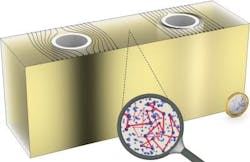Simple broadband nonmetamaterial optical invisibility cloak works in diffusive media
Metamaterial invisibility cloaks are rather complex and work in certain situations only (usually including very narrow wavelength ranges). The laws of physics prevent an optical invisibility cloak from making objects in air invisible for any directions, colors, and polarizations. If the medium is changed, however, it becomes much easier to hide objects. Physicists at KIT (Karlsruhe Institute of Technology) have now succeeded in manufacturing with relatively simple means and testing an ideal invisibility cloak for diffusive light-scattering media, such as fog or milk.1
Diffusive media let the light in, but hide the light source. "This property of light-scattering media can be used to hide objects inside," says Robert Schittny, first author of the study. "The new invisibility cloaks have a rather simple structure."
No more shadows
In the experiment, Schittny used an extended light source to illuminate a Plexiglas tank of a few centimeters in width from the back. The tank was filled with a white, turbid liquid. Objects inside cast a visible shadow onto the tank wall. Simple metal cylinders or spheres of a few centimeters in diameter were used as test objects. To hide them, they were first coated with a white dispersion paint, such that the light was reflected in a diffusive manner.
To pass the light around the object, the researchers applied a thin shell made of the transparent silicone material polydimethylsiloxane (PDMS), to which a certain concentration of light-scattering melamine microparticles was added. The silicon/melamine shell caused a quicker diffusion than in the environment and, thus, passed the light around the objects. Hence, they no longer cast a shadow.
"Ideal optical invisibility cloaks in air have a drawback," says Martin Wegener of KITy. "They violate Albert Einstein’s theory of relativity that prescribes an upper limit for the speed of light. "In diffuse media, in which light is scattered several times, however, the effective speed of light is reduced. Here, ideal invisibility cloaks can be realized."
"We will have to wait a long time for real applications, but with the help of the principle found, it might be possible to produce frosted glass panes for bathrooms with integrated metal bars or sensors against burglary," says Schittny. "These sensors or bars would be invisible from the inside and outside."
Source: http://www.kit.edu/kit/english/pi_2014_15233.php
REFERENCE:
1. R. Schittny et al., Science (2014); doi: 10.1126/science.1254524

John Wallace | Senior Technical Editor (1998-2022)
John Wallace was with Laser Focus World for nearly 25 years, retiring in late June 2022. He obtained a bachelor's degree in mechanical engineering and physics at Rutgers University and a master's in optical engineering at the University of Rochester. Before becoming an editor, John worked as an engineer at RCA, Exxon, Eastman Kodak, and GCA Corporation.
